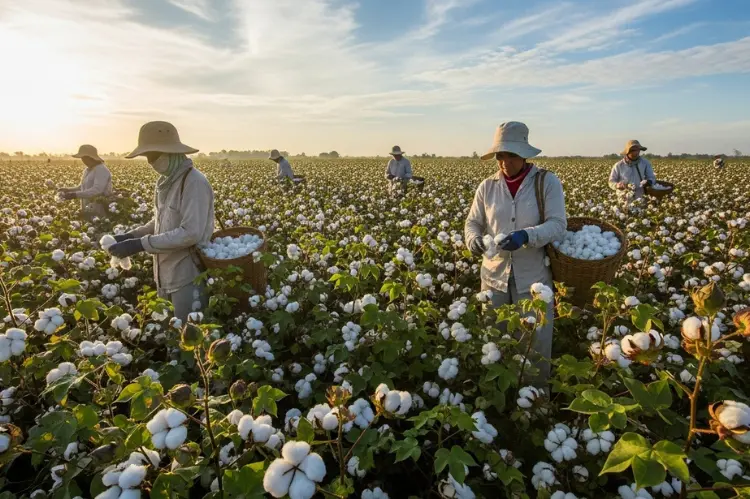When you choose organic fabrics for your child’s clothing, you make a decision that supports their health now and in the years ahead. These materials are grown and processed without harmful chemicals, reducing exposure to irritants that can cause skin problems or allergic reactions. Organic fabrics help protect your child’s developing body from unnecessary toxins and create a safer, more comfortable environment for their skin.
Organic cotton, hemp, and linen not only feel soft but also hold up well through frequent washing and active play. Their natural strength and breathability make them ideal for long-term use, ensuring your child’s clothes remain durable and gentle over time. By choosing these materials, you also support sustainable farming practices that benefit both your family and the environment.
This choice goes beyond comfort—it’s an investment in lasting wellness. As you explore the key long-term health benefits and environmental advantages of organic fabrics, you’ll see how small changes in what your child wears can make a meaningful difference for their future.
Key Long-Term Health Benefits of Organic Fabrics for Kids

Using organic fabrics in your child’s clothing supports healthier skin, better comfort, and longer-lasting wear. These materials limit exposure to harmful chemicals, allow skin to breathe naturally, and maintain durability through frequent use and washing.
Reduced Chemical Exposure and Sensitive Skin Protection

Organic fabrics, such as organic cotton, are grown without synthetic pesticides, herbicides, or chemical fertilizers. This reduces your child’s contact with residues that can irritate sensitive skin or cause long-term health concerns. Conventional fabrics often contain chemical dyes and finishes that may release volatile compounds over time.
Children’s skin is thinner and more absorbent than adults’. Using organic clothing helps minimize the absorption of these substances. This is especially beneficial for babies and toddlers who experience frequent skin contact with their clothes and bedding.
You can find items like organic cotton underwear for girls that meet strict organic standards. These garments provide a safer option for everyday wear, reducing unnecessary chemical exposure and supporting skin health from an early age.
Enhanced Comfort fand Breathability for Children

Natural fibers found in organic fabrics allow air to circulate more effectively than synthetic materials. This breathability helps regulate body temperature, especially during play or sleep. Your child stays cooler in warm weather and comfortable in cooler conditions.
Organic cotton fibers are softer and less processed, which enhances comfort against the skin. The absence of harsh chemical treatments preserves the fabric’s natural texture, making it gentle for children who dislike rough or stiff materials.
Because these fabrics wick moisture efficiently, they help prevent overheating and discomfort caused by sweat. This makes organic clothing a practical choice for daily wear, especially for children with active lifestyles.
Minimized Risk of Allergies and Skin Irritation

Children prone to eczema, rashes, or allergies often benefit from organic fabrics. The lack of synthetic dyes, bleaches, or chemical residues reduces the chance of allergic reactions. Organic cotton and other natural fibers create a neutral surface that rarely triggers irritation.
You can identify high-quality organic clothing by certifications such as GOTS (Global Organic Textile Standard). These certifications ensure materials are processed under strict environmental and safety guidelines. Choosing certified fabrics helps you avoid hidden allergens commonly present in non-organic textiles.
Over time, consistent use of organic clothing can help maintain skin balance and reduce flare-ups. It supports the skin’s natural barrier, allowing it to remain healthy and resilient.
Durability and Longevity for Active Kids

Organic fabrics often last longer than conventional ones due to the strength of untreated natural fibers. Organic cotton retains its structure after repeated washing, resisting thinning and pilling. This durability makes it ideal for active kids who frequently move, play, and explore.
Because organic fabrics are not weakened by harsh chemical treatments, they maintain their softness and shape over time. Parents find that garments remain comfortable even after months of wear, reducing the need for frequent replacements.
Durable organic clothing not only supports your child’s comfort but also promotes sustainability. Fewer replacements mean less waste and a smaller environmental footprint, aligning with long-term health and environmental goals.
Environmental and Safety Advantages of Choosing Organic Materials
Organic materials reduce exposure to harmful chemicals, limit pollution from textile production, and support farming systems that maintain soil and water health. They also help you avoid synthetic fibers that release microplastics and ensure that certified standards protect both people and the environment.
Lower Environmental Impact and Organic Farming Practices

Organic farming methods rely on natural fertilizers, crop rotation, and pest control without synthetic pesticides or herbicides. These practices protect soil structure and promote biodiversity. You support ecosystems that sustain pollinators and beneficial insects when you choose organic materials.
Conventional cotton farming often uses heavy irrigation and chemical inputs that degrade land and water quality. Organic cotton, by contrast, uses up to 90% less water in some regions and avoids toxic runoff. This reduces contamination of rivers and groundwater.
Organic farming also limits greenhouse gas emissions through reduced chemical fertilizer use and improved soil carbon retention. Supporting these systems encourages a more balanced agricultural cycle that benefits both human health and the environment.
Avoidance of Microplastics and Synthetic Fabrics
Synthetic fabrics such as polyester, nylon, and acrylic shed microplastics each time they are washed. These microscopic particles enter waterways, persist in the environment, and can end up in the food chain. Choosing organic materials like cotton, wool, or bamboo avoids this problem entirely.
Microplastics do not biodegrade. They accumulate in marine ecosystems and may affect aquatic life. By using organic textiles, you reduce your contribution to this growing issue and help maintain cleaner oceans.
Natural fibers also release fewer volatile organic compounds (VOCs) during production and wear, improving indoor air quality. For children, whose skin and respiratory systems are more sensitive, organic fabrics provide a safer and more breathable alternative.
Role of Certifications: GOTS and the Global Organic Textile Standard
Certifications such as GOTS (Global Organic Textile Standard) ensure that organic textiles meet strict environmental and social criteria. Products with this label must contain a minimum of 70% certified organic fibers and exclude hazardous substances like formaldehyde or heavy metals.
GOTS certification also verifies ethical labor practices and wastewater treatment at every production stage. This transparency helps you identify products that align with sustainable values rather than marketing claims.
Other certifications, such as Oeko-Tex Standard 100, complement GOTS by testing for harmful residues in finished fabrics. Relying on these standards allows you to make informed choices and prioritize materials that meet verified safety and sustainability benchmarks.
Benefits of Hemp and Linen as Natural Alternatives

Hemp and linen are durable, low-impact fibers that require minimal chemical input. Hemp grows quickly, suppresses weeds naturally, and enriches the soil with organic matter. It consumes significantly less water than cotton and resists pests without synthetic treatments.
Linen, made from the flax plant, thrives in cooler climates and needs little irrigation or fertilizer. Its natural strength and breathability make it ideal for children’s clothing and bedding. Both fibers biodegrade easily, leaving no synthetic residue.
By selecting hemp or linen, you support renewable crops that contribute to a circular textile economy. These materials demonstrate how natural fibers can meet modern needs while maintaining environmental integrity.
Conclusion
Choosing organic fabrics for your child’s clothing and bedding supports both health and environmental well-being. You reduce your child’s exposure to synthetic chemicals, pesticides, and dyes that can irritate sensitive skin or cause allergic reactions.
These materials—such as organic cotton, linen, and hemp—allow the skin to breathe and maintain comfort while remaining durable and biodegradable. Over time, this choice helps create a cleaner home environment and supports more sustainable production practices.
By selecting organic fabrics, you invest in your child’s comfort and long-term health while contributing to a safer, more responsible textile industry.

